Physical Address
304 North Cardinal St.
Dorchester Center, MA 02124
Careful history and examination documentation are required for ocular trauma patients.
Tissue adhesive may repair corneal perforations less than 2 mm in diameter.
Careful primary surgical repair may eliminate the need for secondary surgical intervention.
Wound override should be avoided in restoration of the normal corneal curvature.
Repositioning and repair of iris trauma requires specific suturing techniques.
Anterior segment intraocular foreign bodies require prompt identification and removal.
Postoperative care following surgical repair of globe injuries requires antibiotic prophylaxis and timely suture removal. Visual rehabilitation requires management of postoperative irregular astigmatism.
The initial evaluation of the patient with ocular trauma is critical, since it will determine subsequent diagnostic and therapeutic interventions, which may require immediate action. The examiner must adopt a logical, methodical, and thorough approach to each trauma patient. The ocular exam should occur after any potential life-threatening injuries have been identified and managed. The goals of the initial evaluation should be to perform and document a complete ophthalmologic exam, recognize prior potential influencing medical and ocular conditions, localize any foreign bodies, and ultimately develop a therapeutic plan.
In the face of ocular trauma, the patient may not be able to provide a detailed history, so any available family members or witnesses to the injury may be interviewed. Past ocular and medical history, including any previous ophthalmic surgery or prior ophthalmic medical conditions, especially those associated with diminished visual acuity, are important. Previously decreased vision may, in part, explain how the initial trauma could have occurred and be an important prognostic indicator of potential visual recovery.
Specific questions should determine whether the patient was wearing protective eye wear, spectacles, or contact lenses as well as the activity of the patient at the time of injury, the involved parties, exactly how the injury occurred, and how events progressed after the injury. Since many of these cases may result in legal action years after the initial injury, the notes of the initial examiner may be the only source of recall available before legal testimony.
Foreign bodies should always be suspected when examining a patient with anterior segment trauma. The source and composition of the foreign body determines the potential for ocular toxicity (iron or copper versus glass or plastic) and influences imaging techniques used to determine the location. A metallic foreign body resulting from metal striking metal is usually sterile due to the heat generated by the striking force, whereas a tree branch, vegetable matter, or farm instrument carries a high-risk for microbial contamination ( Box 149.1 ). ,
Source material
Composition
Activity at time of injury
Origin
Size and shape
Energy
Temperature
Probable trajectory
Risk of microbial contamination
The energy transferred to the globe and orbit in blunt trauma determines the degree of ocular damage. , The globe may rupture externally or internally. Scleral rupture occurs most commonly behind the insertions of rectus muscles. However, in a patient who has undergone incisional keratotomy (radial or astigmatic), the previous incisions are the most likely point of rupture ( Fig. 149.1 ). Internal rupture, such as tears in the ciliary body, may result in hyphema or angle recession. Rupture of the iris sphincter may result in traumatic mydriasis.
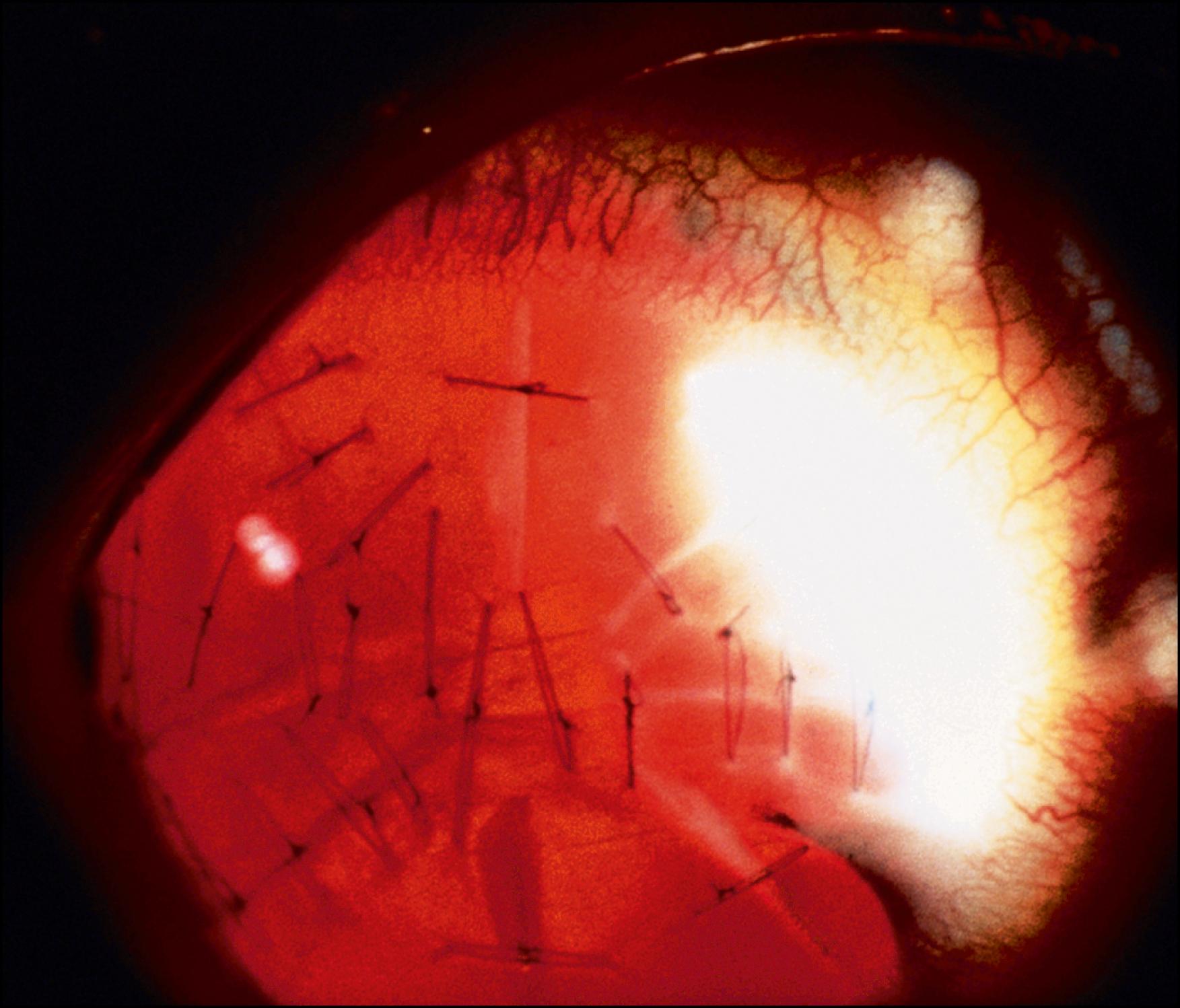
Whenever possible, the trauma patient should be evaluated in a fully equipped eye examination room and a complete examination should be obtained. External examination of the face and lids includes documentation of any external injury or laceration. Any abnormal position of the globe relative to other bony structures, including the presence of subcutaneous emphysema, lid position, function, and any particulate matter on the lids or face, alerts the examiner to the possibility of a foreign body injury.
In any ocular trauma, the goal is to obtain the best objective estimate of visual function. A baseline visual acuity and pupil examination is an important prognostic indicator. This is performed with the near vision card and a pinhole or standard +2.00 diopter lens. When these are not available, any printed material may be used. Desmarres retractors or a lid speculum may be needed to elevate severely swollen lids and evaluate the vision; undue pressure should be avoided to prevent iatrogenic injury in a possible open globe. Pupil examination may indicate intracranial pathology or direct injury to the optic nerve, and in the unconscious patient, is the only indicator of visual function. The presence or absence of a relative afferent pupillary defect must be documented, as must the pupil shape, location, and size. Determination of a relative afferent pupillary defect may require reverse testing. If possible, assess confrontation visual fields at the time of initial examination. As always, the judgment of the initial examiner is used in assessing the necessity of tests beyond the baseline visual acuity and pupil examination in the triage of trauma victims.
A portable slit lamp is necessary for children and patients who are unconscious or in cervical collars. Examination begins with inspection of the lids and conjunctiva; the extent of subconjunctival hemorrhage and the presence of conjunctival chemosis is recorded.
Corneal lacerations, abrasions, or foreign bodies raise the suspicion of possible globe perforation. If the globe is thought to be intact, the upper lid is everted to remove any retained or embedded foreign material in the upper fornix. The position and depth of corneal foreign bodies, as well as the depth and extent of a laceration, is documented ( Fig. 149.2 ). Seidel testing may be necessary to determine whether a full-thickness corneal laceration exists. If no leakage of aqueous is present, gentle pressure applied to the globe will delineate any self-sealing perforations. If leakage of aqueous is present, the remainder of the examination proceeds with minimal trauma ( Fig. 149.3 ), and no topical medications are placed in the eye for fear of entry into the anterior chamber. The anterior chamber may be abnormally shallow in penetrating or perforating injuries. Conversely, a deep chamber may result from acute angle recession, lens dislocation, or posterior globe rupture. The presence of blood, lens fragments, vitreous, or foreign bodies is documented. Foreign bodies that penetrate the anterior chamber but fail to embed in the iris or lens may fall to the angle at the 6 o’clock position and are extremely difficult to see on routine slit lamp examination. Application of a four-mirror lens will help identify intracameral foreign bodies but is postponed in an open globe injury ( Fig. 149.4 ).
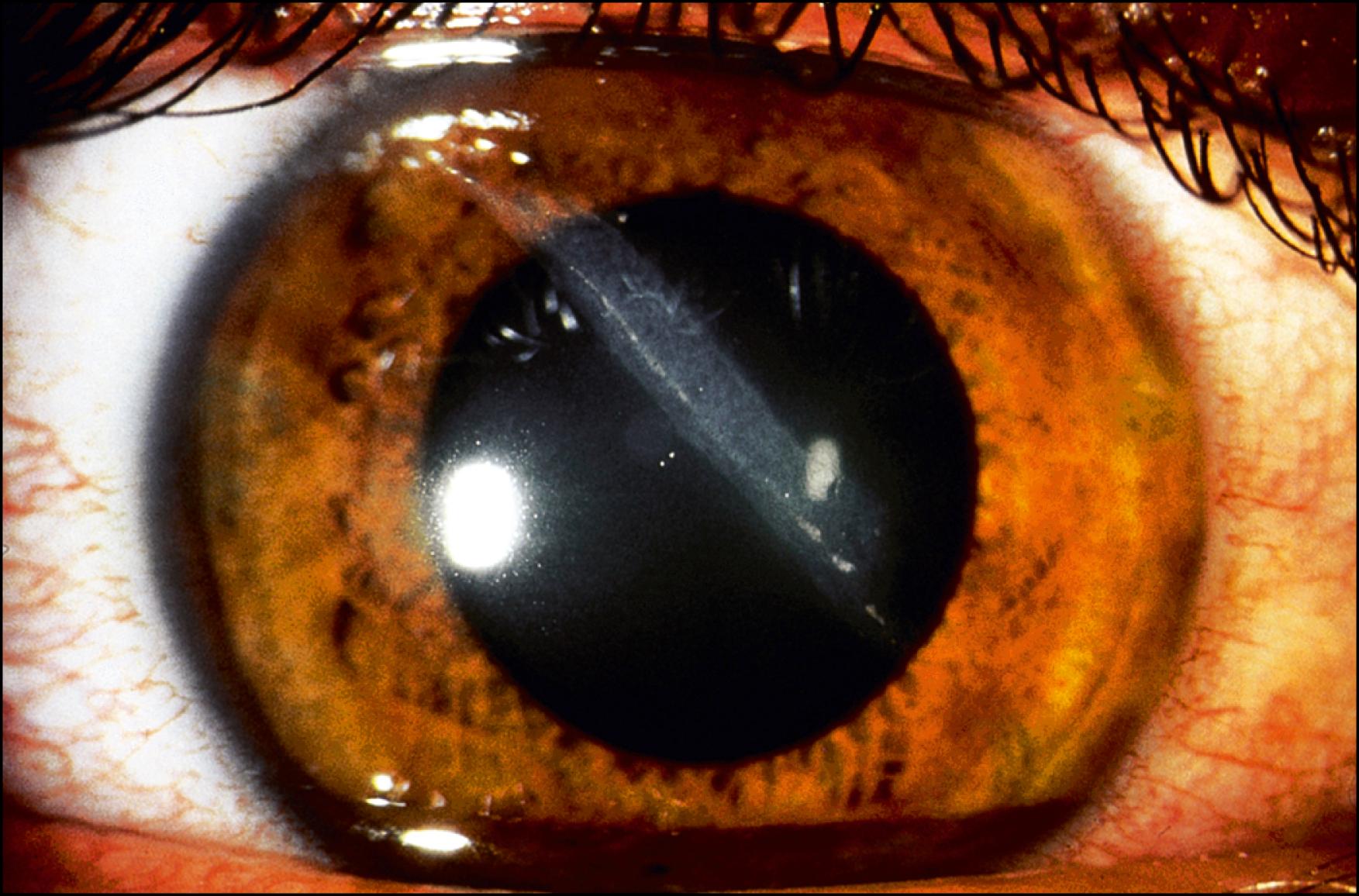
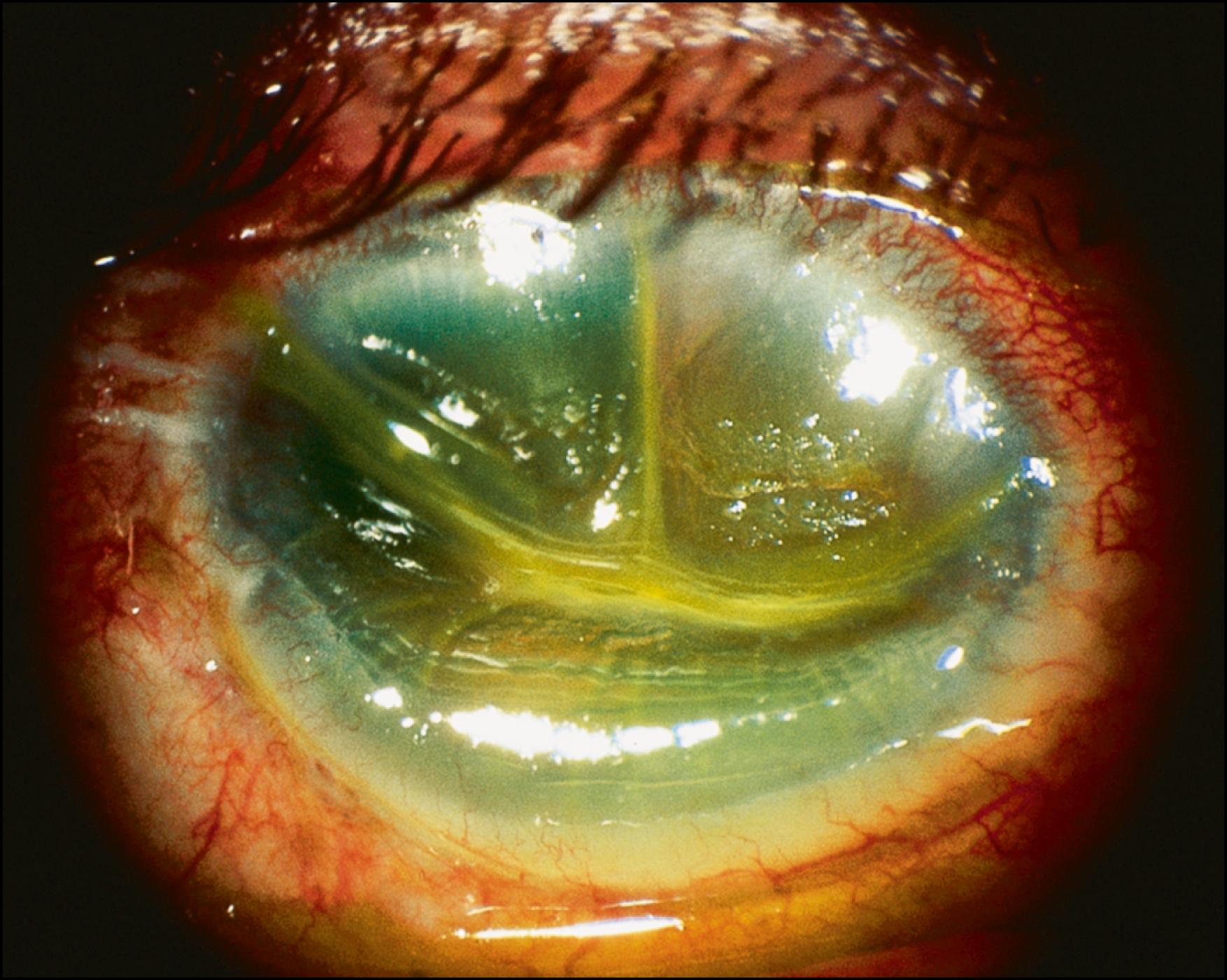
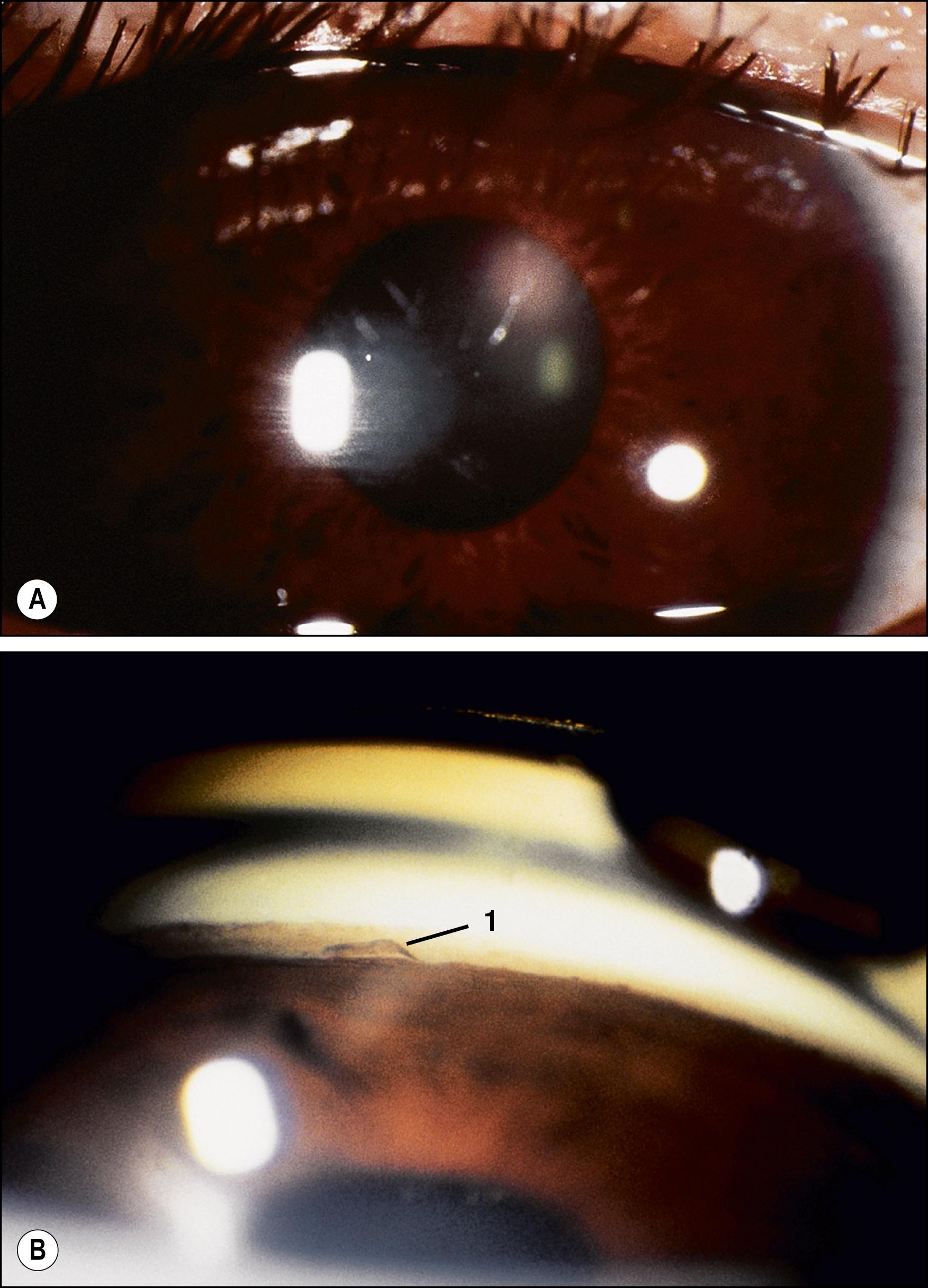
Inspection of the iris includes the overall contour and geometry by both direct and retroillumination to detect small holes or perforations, which are caused by intraocular foreign bodies. These iris defects help estimate the location of foreign bodies. Peaking of the pupil may indicate vitreous prolapse into the anterior chamber or iris prolapse through the wound ( Fig. 149.5 ). A hyphema may obscure the iris details or a foreign body. Sphincter tears and areas of iridodialysis are noted. Iridodonesis indicates likely dislocation of the lens with associated zonular rupture. Capsular perforation or rupture causes regional opacification of the crystalline lens. Free-floating lens fragments or flocculent material in the anterior chamber indicate obvious lens rupture. The presence or absence and location of an intraocular lens (IOL) implant are noted. In the presence of an obvious corneal laceration or ruptured globe, measurement of intraocular pressure is inappropriate. When globe rupture is not obvious, low intraocular pressure may suggest occult rupture; normal or elevated intraocular pressure does not exclude this condition. Low intraocular pressure may also occur with a cyclodialysis cleft. The least traumatic method of measuring the intraocular pressure is recommended.
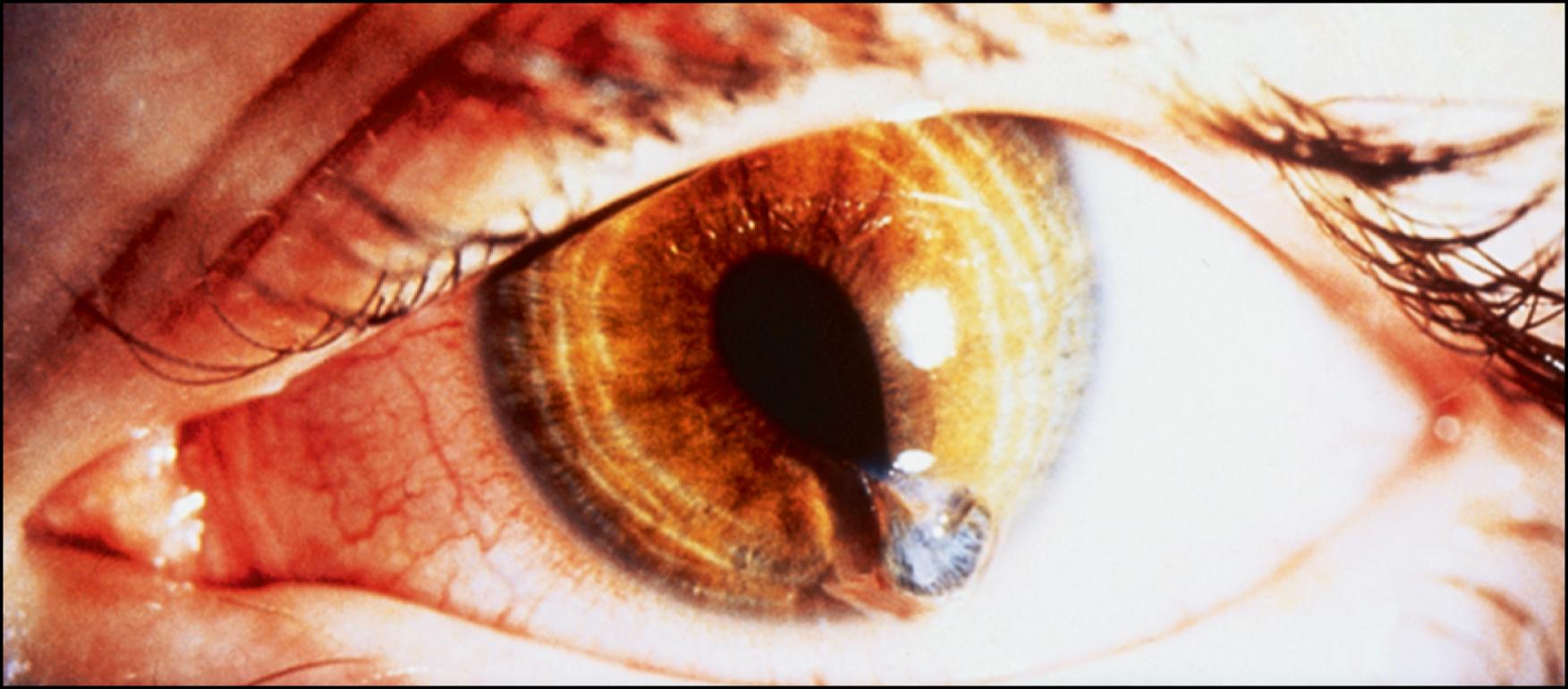
Examination of the vitreous and retina may be performed initially at the slit lamp unless large quantities of vitreous hemorrhage preclude observation of the retina. The presence of red blood cells and pigment in the vitreous may indicate retinal tears. Every effort should be made to view the retina during initial examination, as the initial examiner may be the only one to see the posterior pole in the face of increasing ocular hemorrhage or opacification of the lens. Retinal detachment, choroidal detachment, or choroidal ruptures may all be seen in blunt or penetrating trauma.
Plain film radiography offers advantages in depicting the shape and number of metallic foreign bodies or localizing orbital wall fractures. In the case of a suspected metallic foreign body, a negative plain film may make more expensive tests unnecessary. , Computed tomography (CT) scanning in the traumatized eye and orbit detects both metallic and nonmetallic radio dense foreign bodies 1 mm in size using overlapping 1.5 mm sections. Bone-free projections are used to detect small radiolucent foreign bodies in the anterior segment and help diagnose orbital fractures and optic nerve avulsions. Wooden foreign bodies can be difficult to detect on CT because they appear hypoattenuating, similar to air. CT scanning may also assist in the diagnosis of occult globe rupture based upon subtle asymmetry in AC depth. Magnetic resonance imaging (MRI) detects a wide variety of vegetable, plastic, glass, and radiolucent foreign bodies in the eye, orbit, and adnexa. Surface coils allow higher resolution of orbital imaging in cases of ocular trauma ( Fig. 149.6 ). The potential for tissue damage from movement of a ferromagnetic foreign body precludes the use of MRI as a screening technique.
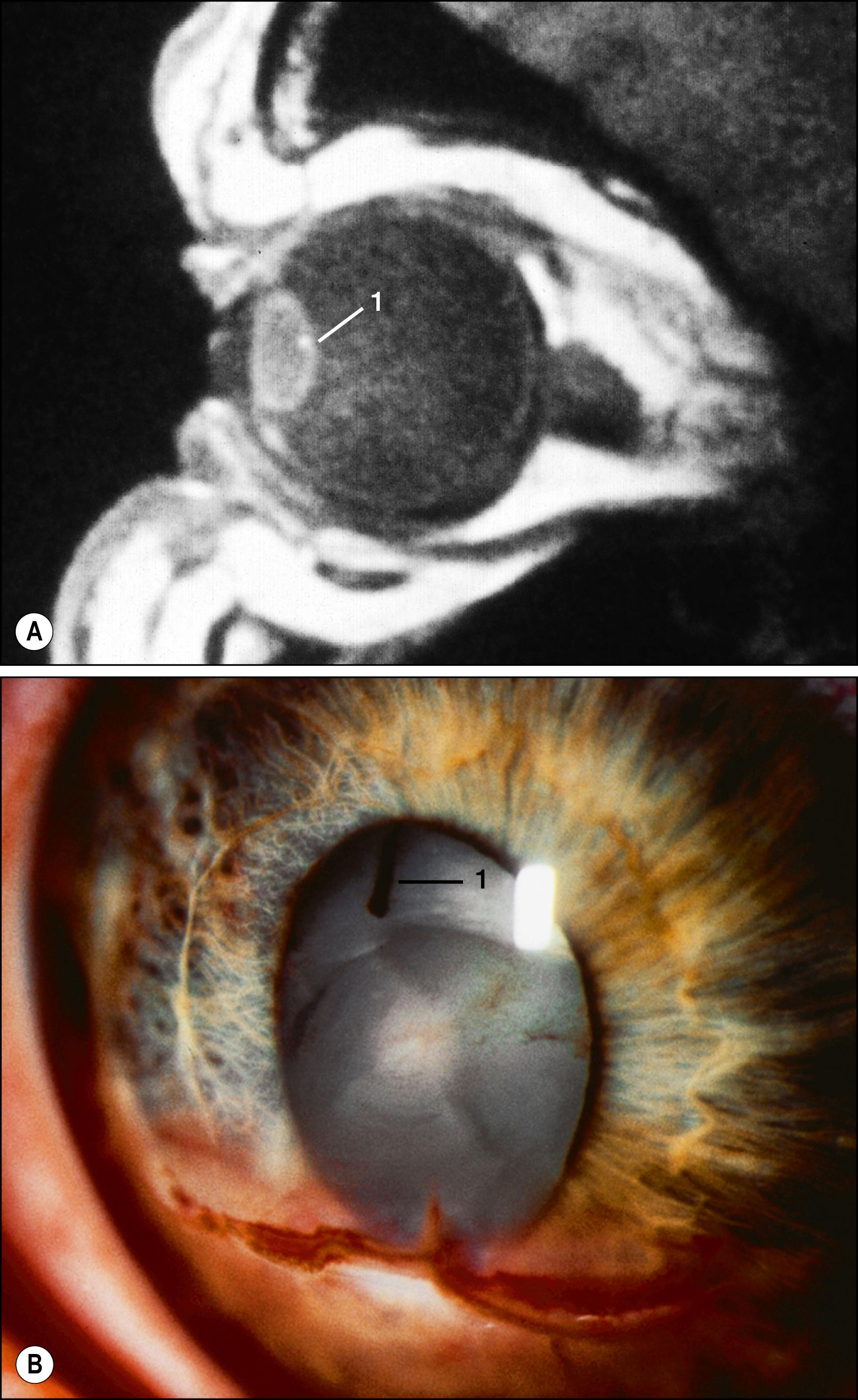
If there is no view of the posterior pole in an intact globe after blunt trauma, B-scan ultrasonography is used to detect a vitreous hemorrhage, retinal detachment, choroidal detachment, or intralenticular foreign body. Glass and metallic foreign bodies are very reflective and appear as bright areas on B-scan. Standard B-scan ultrasonography may determine whether a small foreign body is within or immediately outside the globe. Ultrasound biomicroscopy (UBM) and anterior segment OCT (AS-OCT) provides angle visualization when gonioscopy is not possible and can aid in the localization and removal of small intraocular foreign bodies, particularly in the angle, ciliary sulcus, and ciliary body. Additionally, UBM and AS-OCT can be used to evaluate for posterior capsule integrity and surgical planning for traumatic cataracts. Although UBM is more accurate, AS-OCT is a noncontact imaging modality and is particularly valuable in open globe injuries. Ocular CT can aid in the localization and identification of anterior segment foreign bodies and assist in the visualization of otherwise difficult areas to visualize, such as the sulcus, anterior chamber angle, and the ciliary body.
Corneal perforations less than 2 mm in diameter can be sealed with the application of tissue glue. Emerging techniques may increase the indications for tissue sealants in trauma repair. Several glues, such as cyanoacrylate, polymerize on contact with liquid. After polymerization, the glue creates a rough surface; therefore it is applied sparingly to areas of the globe that are dry and devoid of epithelium. Application techniques are varied, including a drip technique using a syringe. Alternatively, a polyethylene disk may be placed on the end of an applicator stick with ophthalmic ointment. The glue is then placed on the opposite side of the polyethylene disk and applied to the area of perforation. After the application of tissue glue, a therapeutic contact lens is placed to avoid rubbing of the glue against the tarsal conjunctival surface and decrease patient discomfort. Tissue glue has antibacterial properties, so corneal infection is rare in its presence, yet a surrounding inflammatory infiltrate is commonly seen. Frequent applications of broad-spectrum topical antibiotic drops are recommended while the glue remains in place. Tissue loss may occur if the glue comes off while adherent to part of the underlying tissue. This is most commonly seen when tissue glue is applied liberally to a descemetocele.
Become a Clinical Tree membership for Full access and enjoy Unlimited articles
If you are a member. Log in here